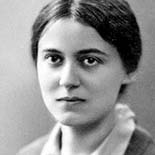 Edith Stein (religious name Saint Teresia Benedicta a Cruce OCD; also known as Saint Teresa Benedicta of the Cross or Saint Edith Stein; October 12, 1891 – August 9, 1942) was a German Jewish philosopher who converted to Christianity and became a Discalced Carmelite nun. She is canonized as a martyr and saint of the Catholic Church; she is also one of six patron saints of Europe.
Edith Stein (religious name Saint Teresia Benedicta a Cruce OCD; also known as Saint Teresa Benedicta of the Cross or Saint Edith Stein; October 12, 1891 – August 9, 1942) was a German Jewish philosopher who converted to Christianity and became a Discalced Carmelite nun. She is canonized as a martyr and saint of the Catholic Church; she is also one of six patron saints of Europe.
She was born into an observant Jewish family, but had become an agnostic by her teenage years. Moved by the tragedies of World War I, in 1915, she took lessons to become a nursing assistant and worked in an infectious diseases hospital. After completing her doctoral thesis at the University of Freiburg in 1916, she obtained an assistantship there.
From reading the life of the reformer of the Carmelite Order, Saint Teresa of Ávila, Edith Stein was drawn to the Christian faith. She was baptized on January 1, 1922 into the Catholic Church. At that point, she wanted to become a Discalced Carmelite nun but was dissuaded by her spiritual mentor, the abbot of Beuron Archabbey. She then taught at a Catholic school of education in Speyer. As a result of the requirement of an “Aryan certificate” for civil servants promulgated by the Nazi government in April 1933 as part of its Law for the Restoration of the Professional Civil Service, she had to quit her teaching position.
Edith Stein was admitted as a postulant to the Discalced Carmelite monastery in Cologne on October 14, on the first vespers of the feast of Saint Teresa of Ávila, and received the religious habit as a novice in April 1934, taking the religious name Teresia Benedicta a Cruce (Teresia in remembrance of Saint Teresa of Ávila, Benedicta in honour of Saint Benedict of Nursia). She made her temporary vows on April 21, 1935, and her perpetual vows on April 21, 1938.
The same year, Teresa Benedicta a Cruce and her biological sister Rosa, by then also a convert and an extern (tertiary of the Order, who would handle the community’s needs outside the monastery), were sent to the Carmelite monastery in Echt, Netherlands, for their safety. In response to the pastoral letter from the Dutch bishops on July 26, 1942, in which they made the treatment of the Jews by the Nazis a central theme, all baptized Catholics of Jewish origin (according to police reports, 244 people) were arrested by the Gestapo on the following Sunday, August 2, 1942. They were sent to the Auschwitz concentration camp, where they were murdered in a gas chamber on 9 August 1942.